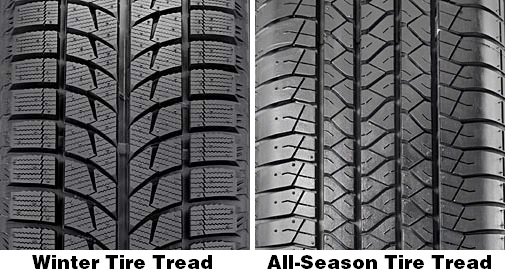
Winter's cold weather causes the rubber tread on all season or summer tire to stiffen and does not provide sufficient traction for wintry conditions. Tire design in tread rubber of winter tires are designed to remain flexible allowing the tire to grip the road better. And its not just tread design, its also the composition of the tire.
It's not uncommon for drivers to think a tire is a tire. However, that is not true.
Tires vary in composition, in tread depth and design and more, all suited for a specific driving purpose and need. Many cars leave the factory with all season tires. Those tires provide a fairly quiet ride, have good tread life and get good fuel economy. They are popular as all season tires offer flexible performance on a bevy of road services having been specifically designed to perform in a variety of conditions. Those conditions include dry roads, wet roads and light winter driving.
Unfortunately, that does not mean that all season tires combine the best performance of both kinds of tires. This translates to all season tires NOT being able to give the safest drive in the winter. An all season tire is not designed to handle extreme winter conditions like safely riding through snow or driving on ice. Also, even if it did not snow one flake, all season tires do not handle really cold weather all that well.
Bridgestone tire uses a great illustrative metaphor stating: "Think of all season tires like tennis shoes. You can wear tennis shoes all year, but they aren't ideal for all situations. It'd be much better to have flip flops on the beach in the summer and boots for the snow."
Last winter in NYC, we learned about treacherous roads with all the snow we had and some of us learned about winter and snow tires because we didn't have them. From heavy and frequent snowfalls, mounds of plowed snow to black ice, our roads proved dangerous and extremely unpredictable.
Those conditions proved very challenging for we NYers because we were not prepared. Wintry conditions needed traction like no other season of the year in our recent history. Last year many learned that winter or snow tires can more successfully and safely meet the combination of cold temperatures, stop and go driving, ice and snow because they are specially designed to perform under the winter conditions we experienced.
Winter tires have deeper tread depths. This design feature reduces snow buildup inside the tread on the tires and therefore these tires provide better traction in snow. Winter tire tread patterns are designed to be mini-conduits to remove snow and slush and expel water leading to a safer drive.
Bridgestone tire states, "Winter tires also feature an increased number of biting edges and high sipe densities, or in other words, thousands of tiny slits in the tread that provide traction on ice."
Tire choice always should depend on what kind of surface you drive on, what your weather patterns are and what features you want in your ride and, therefore, ultimately, where you drive and how you drive.
Whether you drive in Florida or NYC or Alaska, the decision about your tires belongs in the hands of a pro and 106 St Tire & Wheel is here to help you make a sound and scientific decision based on your safety and ours because we are your neighbors here in Queens and our techs drive the same roads you do.